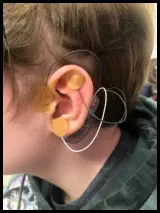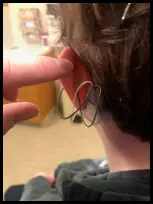© 2024 Zebra Hearts Foundation
Website Design by North Country Website Design

906-367-5404
Testimonials
Joyce and Her Many Attributes
Over the past few years, my
mobility has declined due to the
worsening of my Ehlers-Danlos
Syndrome symptoms. In addition to this, my ability to do
things independently has plummeted. I aspire to stay as
independent and active as possible, despite the new
challenges of my condition. Since receiving the power
wheelchair, I am pleased to say that these aspirations are so
much more achievable. With the independence the chair gives
me, I can go shopping, attend events, and participate longer
in activities that were once incredibly difficult. Everywhere I
go, I no longer have to worry about finding a comfortable seat,
always having someone present in case I need assistance,
nor do I need to worry about hurting myself from standing or
walking too much. Due to how much the power chair helps, it
has also eased the fear I hold of damaging my body and joints
even more when going out, which greatly improves my quality
of life.
Additionally, as many of my friends and family know, I love to
dance. Since the onset of my Ehlers-Danlos Syndrome and
the rapid decline in my mobility, dancing has not been in the
cards for me. However, with this power chair, I am able to
dance in the chair and move freely with it. No more will I have
to sit on the side while others enjoy music at events, I can join
in and do it completely independently. Overall, I can enjoy
even simple daily tasks so much more with this chair because
it alleviates a lot of stress, fatigue, and pain.”
- Shyla Bradley, age 23
Note: Shyla names all
of her mobility aids
and she named her
new electric wheelchair
Joyce because it has a
joystick to maneuverer
the chair.

Want to leave us a testimonial?
You can email your testimonial to info@zebraheartsfoundation.org
or go to one of the links below:
Facebook Reviews
Google Reviews
“
Due to my Ehlers-Danlos Syndrome, I have developed
craniocervical instability which has led to a condition called
Trigeminal Neuralgia. I am often sent into a flare with this pain
when something pushes against my Trigeminal Nerve, which
is located next to the ear and throughout the face. It has been
particularly difficult to find pillows that support my neck but
don't put pressure on this nerve, which has led to many
sleepless nights. I found a pillow that takes the pressure off
this nerve and I am so grateful that the Zebra Hearts
Foundation was able to help me by paying for it. This pillow
has helped significantly with reducing my pain, improving my
sleep, and overall improving my quality of life.”
- Shyla Bradley
“
Austin, 14 years old, has an underlying diagnosis of Ehlers-
Danlos Syndrome. For the past year he has been experiencing
significant abdominal pain. After several tests performed on his
gastrointestinal tract, which all came back as normal, he was
diagnosed with Functional Abdominal Pain. Functional
Abdominal Pain, also known as intractable abdominal pain, is
persistent stomach pain that does not resolve with usual
therapeutic treatment. The pain may be constant or may come
and go.
NeurAxis, Inc. has developed a non-invasive treatment called
the IB-Stim. The IB-Stim is a percutaneous electrical nerve
field stimulator (PENFS) system intended to be used in
patients 11-18 years of age with functional abdominal pain
associated with irritable bowel syndrome (IBS). The IB-Stim is
a non-surgical device that works by sending gentle electrical
impulses into cranial nerve bundles located in the ear. This
stimulation targets brain areas that process pain and helps
reduce functional abdominal pain.
Austin began treatment in April 2023. The IB-Stim was placed
by a trained nurse at the GI doctor’s office. Austin would wear
the device for 5 days straight. The device can be removed at
home and he would be device free for 2 days. He would then
return for a new device placement at the beginning of the
following week. It is recommended that treatment be
implemented for a minimum of 4 weeks.
Austin experienced some skin
discomfort on and around his ear for
the first couple of days after the first
device was placed. He then got used
to the device without many issues.
He was able to sleep well, just was
not able to lay on that side of his
head. By the third week he was
experiencing a decrease in his
abdominal pain. Even to the point where he would occasionally
forget about his symptoms. Due to these hopeful results, we
requested to continue his treatment for 2 additional weeks.
The IB-Stim is not yet covered by many health insurance
companies as many still consider this treatment experimental.
It is currently FDA approved and NeurAxis is advocating for
more insurance companies to approve their treatment. Our
insurance company did not cover the treatment. Our family
qualified for the NeurAxis Patient Assistance program and we
were able to get a significant reduction on the cost of the
device.
Austin would like to thank the Zebra
Hearts Foundation for their support and
for covering the cost of his treatment.
Visit the NeurAxis website below for
additional information on the IB-Stim.
https://ibstim.com/”
- Robin Doubleday, Austin’s mother
“
© 2024 Zebra Hearts Foundation
Website Design by North Country Website Design

Testimonials
Joyce and Her Many Attributes
Over the past few years, my
mobility has declined due to the
worsening of my Ehlers-Danlos
Syndrome symptoms. In addition to
this, my ability to do things independently has plummeted. I
aspire to stay as independent and active as possible, despite the
new challenges of my condition. Since receiving the power
wheelchair, I am pleased to say that these aspirations are so
much more achievable. With the independence the chair gives
me, I can go shopping, attend events, and participate longer in
activities that were once incredibly difficult. Everywhere I go, I no
longer have to worry about finding a comfortable seat, always
having someone present in case I need assistance, nor do I
need to worry about hurting myself from standing or walking too
much. Due to how much the power chair helps, it has also eased
the fear I hold of damaging my body and joints even more when
going out, which greatly improves my quality of life.
Additionally, as many of my friends and family know, I love to
dance. Since the onset of my Ehlers-Danlos Syndrome and the
rapid decline in my mobility, dancing has not been in the cards
for me. However, with this power chair, I am able to dance in the
chair and move freely with it. No more will I have to sit on the
side while others enjoy music at events, I can join in and do it
completely independently. Overall, I can enjoy even simple daily
tasks so much more with this chair because it alleviates a lot of
stress, fatigue, and pain.”
- Shyla Bradley, age 23
“
Note: Shyla names all
of her mobility aids and
she named her new
electric wheelchair
Joyce because it has a
joystick to maneuverer
the chair.

Want to leave us a testimonial?
You can email your testimonial to
info@zebraheartsfoundation.org or go to one of the links below:
Facebook Reviews
Google Reviews
Due to my Ehlers-Danlos Syndrome, I have developed
craniocervical instability which has led to a condition called
Trigeminal Neuralgia. I am often sent into a flare with this pain
when something pushes against my Trigeminal Nerve, which is
located next to the ear and throughout the face. It has been
particularly difficult to find pillows that support my neck but don't
put pressure on this nerve, which has led to many sleepless
nights. I found a pillow that takes the pressure off this nerve and I
am so grateful that the Zebra Hearts Foundation was able to help
me by paying for it. This pillow has helped significantly with
reducing my pain, improving my sleep, and overall improving my
quality of life.”
- Shyla Bradley
“
Austin, 14 years old, has an underlying diagnosis of Ehlers-
Danlos Syndrome. For the past year he has been experiencing
significant abdominal pain. After several tests performed on his
gastrointestinal tract, which all came back as normal, he was
diagnosed with Functional Abdominal Pain. Functional
Abdominal Pain, also known as intractable abdominal pain, is
persistent stomach pain that does not resolve with usual
therapeutic treatment. The pain may be constant or may come
and go.
NeurAxis, Inc. has developed a non-invasive treatment called the
IB-Stim. The IB-Stim is a percutaneous electrical nerve field
stimulator (PENFS) system intended to be used in patients 11-18
years of age with functional abdominal pain associated with
irritable bowel syndrome (IBS). The IB-Stim is a non-surgical
device that works by sending gentle electrical impulses into
cranial nerve bundles located in the ear. This stimulation targets
brain areas that process pain and helps reduce functional
abdominal pain.
Austin began treatment in April 2023. The IB-Stim was placed by
a trained nurse at the GI doctor’s office. Austin would wear the
device for 5 days straight. The device can be removed at home
and he would be device free for 2 days. He would then return for
a new device placement at the beginning of the following week. It
is recommended that treatment be implemented for a minimum
of 4 weeks.
Austin experienced some skin
discomfort on and around his ear for
the first couple of days after the first
device was placed. He then got used to
the device without many issues. He
was able to sleep well, just was not
able to lay on that side of his head. By
the third week he was experiencing a
decrease in his abdominal pain. Even
to the point where he would occasionally forget about his
symptoms. Due to these hopeful results, we requested to
continue his treatment for 2 additional weeks.
The IB-Stim is not yet covered by many health insurance
companies as many still consider this treatment experimental. It
is currently FDA approved and NeurAxis is advocating for more
insurance companies to approve their treatment. Our insurance
company did not cover the treatment. Our family qualified for the
NeurAxis Patient Assistance program and we were able to get a
significant reduction on the cost of the device.
Austin would like to thank the Zebra
Hearts Foundation for their support and
for covering the cost of his treatment.
Visit the NeurAxis website below for
additional information on the IB-Stim.
https://ibstim.com/”
- Robin Doubleday, Austin’s mother
“
























